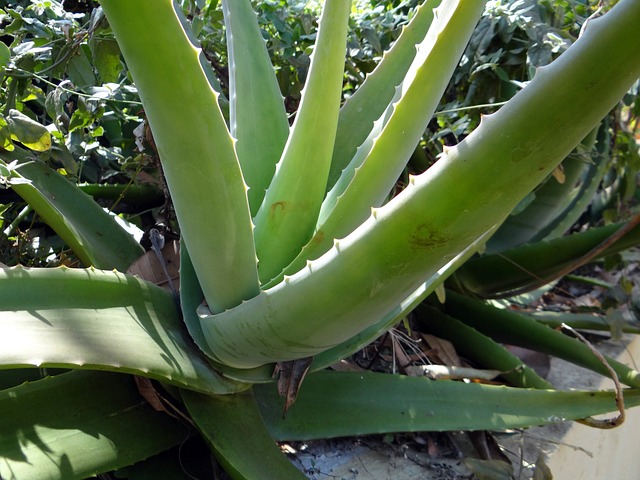Aloe vera, with its striking rosette of fleshy, serrated leaves and numerous healing properties, is a beloved and versatile succulent plant. Whether you’re a seasoned gardener or a novice plant enthusiast, chances are you’ve encountered an aloe plant at some point. Aloe vera, in particular, has gained immense popularity for its soothing gel, often used to treat burns and skin irritations. But when winter comes knocking with its frosty fingers, many plant lovers wonder, can aloe plants survive the harsh cold?
Aloe plants, including the popular aloe vera, are not naturally suited to harsh cold conditions. They are highly sensitive to frost and freezing temperatures, which can lead to irreversible damage such as wilting and browning of leaves. To ensure the survival of aloe plants during the cold, it is advisable to bring them indoors if you live in an area with freezing winters or provide adequate protection, such as covering them with frost cloth, and limiting their exposure to cold temperatures.
In this comprehensive guide, we’ll explore the winter survival strategies for aloe plants and offer tips on how to protect them during the colder months.
Understanding Aloe Plants
Before delving into the specifics of winter care for aloe plants, let’s get to know these remarkable succulents a bit better.
Aloe Vera – A Remarkable Succulent
Aloe vera, scientifically known as Aloe barbadensis miller, is a succulent plant that hails from the arid regions of the Arabian Peninsula. Its succulent leaves are packed with a clear gel renowned for its therapeutic properties. This gel is often used topically to treat sunburns, minor cuts, and skin irritations. Apart from its medicinal value, aloe vera is also a popular houseplant due to its easy care and attractive appearance.
Aloe Plants and Winter: A Chilly Challenge
While aloe vera is naturally adapted to arid climates, it faces a unique set of challenges when exposed to winter conditions, especially in regions with cold, frosty winters. Aloe plants thrive in warm, sunny environments and are not frost-tolerant. Therefore, it’s crucial to understand their vulnerabilities during the winter season and take appropriate measures to ensure their survival.
Vulnerabilities During Winter
- Frost Sensitivity: Aloe plants are highly sensitive to frost and freezing temperatures. Exposure to frost can cause irreversible damage to the plant’s tissues, leading to wilting, browning, and even death.
- Reduced Sunlight: Winter typically comes with shorter daylight hours and reduced sunlight intensity. Aloe plants are sun-loving succulents, and the lack of sufficient light can weaken them over time.
- Overwatering Risk: During the winter, aloe plants experience reduced growth and minimal water requirements. Overwatering during this period can lead to root rot, a common problem in succulents.
- Pest Infestations: In some regions, pests that are dormant during the warmer months become active in winter. Aloe plants can be vulnerable to pests like mealybugs and scale insects.
Now that we understand the challenges aloe plants face during the winter, let’s explore strategies for ensuring their survival and well-being.
Winter Care for Aloe Plants
-
Choosing the Right Location
The first step in ensuring your aloe plant’s survival during the winter is selecting the right location. If you’re growing aloe vera outdoors and you live in a region with harsh winters, consider bringing your aloe plant inside before the cold weather sets in. Aloe vera can be grown as a potted plant indoors and will thrive in a sunny windowsill.
For outdoor aloe plants, choose a location that receives ample sunlight and is sheltered from strong winds. A south-facing exposure is ideal for maximum sunlight exposure.
-
Temperature Considerations
Aloe vera prefers temperatures between 59°F (15°C) and 77°F (25°C). It can tolerate occasional drops below this range, but prolonged exposure to temperatures below 50°F (10°C) can harm the plant. To protect your aloe plant from frost and cold temperatures, consider the following options:
- Bring Indoors: If possible, bring your aloe plant indoors during the winter months. Place it near a sunny window to ensure it receives adequate light.
- Cover Outdoor Plants: If you cannot bring your outdoor aloe plant inside, cover it with a frost cloth or blanket on cold nights to insulate it from freezing temperatures.
- Move to a Greenhouse: If you have access to a greenhouse, moving your aloe plant there for the winter can provide a controlled environment with suitable temperatures and light.
-
Lighting
Adequate light is crucial for the health of your aloe plant. During the winter, when natural sunlight is limited, consider supplementing with artificial lighting. Place a grow light or fluorescent light fixture above your aloe plant to ensure it receives 12 to 14 hours of light each day. Keep the light source a few inches above the plant to simulate natural sunlight.
-
Watering Carefully
Aloe plants are drought-tolerant, and their water requirements decrease significantly in the winter. Overwatering is a common mistake during this season, as the soil takes longer to dry out. Here are some watering tips for winter care:
- Reduce Frequency: Water your aloe plant sparingly during the winter. Allow the top inch or two of soil to dry out completely between watering sessions.
- Use the Right Soil: Ensure that your aloe plant is potted in a well-draining succulent or cactus mix to prevent waterlogged soil.
- Monitor Closely: Pay attention to the plant’s leaves; if they start to appear waterlogged or translucent, you may be overwatering. Adjust your watering schedule accordingly.
-
Protection from Pests
Winter can bring out pests that were dormant during the warmer months. Regularly inspect your aloe plant for signs of infestations, such as yellowing or discolored leaves, sticky residue, or small insects. If you notice pests, take action immediately:
- Isolate: Isolate the affected plant to prevent the pests from spreading to other plants.
- Treatment: Use a mild insecticidal soap or neem oil to treat the affected areas of the plant. Follow the manufacturer’s instructions for application.
-
Pruning and Maintenance
In late fall or early winter, consider pruning your aloe plant to remove any dead or damaged leaves. This not only improves the plant’s appearance but also encourages new growth when spring arrives. Use clean, sharp pruning shears to make clean cuts and minimize stress on the plant.
-
Avoiding Drafts
Keep your indoor aloe plant away from drafts caused by doors, windows, or heating vents. Cold drafts can be harmful to the plant and may lead to temperature fluctuations that it cannot tolerate.
-
Fertilization
Aloe vera is not a heavy feeder, and its nutrient requirements are relatively low. During the winter, it’s best to refrain from fertilizing your aloe plant. Resume feeding with a balanced, diluted fertilizer in the spring when the plant starts actively growing again.
-
Repotting (if Necessary)
If your aloe plant has outgrown its pot or if you notice that it’s struggling due to crowded roots, consider repotting it in the spring. Repotting allows you to refresh the soil, provide more space for growth, and check the health of the roots.
Signs of Stress and How to Address Them
Even with the best care, aloe plants may still show signs of stress during the winter months. Here are some common issues you might encounter and how to address them:
- Leaf Discoloration: If your aloe plant’s leaves start turning brown or reddish-brown, it may be a sign of cold damage or overwatering. Trim the affected leaves and adjust your care routine to prevent further stress.
- Leggy Growth: Insufficient light can cause your aloe plant to become leggy, with stretched-out stems. To correct this, provide more light or move the plant to a sunnier location.
- Yellowing Leaves: Yellowing leaves can be a sign of overwatering or a soil moisture imbalance. Adjust your watering schedule and ensure that the soil dries out between waterings.
- Pest Infestations: If you notice pests on your aloe plant, follow the previously mentioned steps for isolation and treatment with insecticidal soap or neem oil.
Preparing Aloe Plants for Spring
As winter transitions into spring, your aloe plant will become more active and require different care. Here’s how to prepare your aloe for the warmer season:
- Increase Watering: With the arrival of spring and longer days, gradually increase the frequency of watering. Continue to let the soil dry out between waterings to prevent root rot.
- Resume Fertilization: Begin feeding your aloe plant with a balanced, diluted fertilizer as it enters its growing season. Follow the recommended dosage on the fertilizer label.
- Repot (if needed): If you didn’t repot your aloe plant in the winter but it has outgrown its container, now is a good time to repot it. Choose a slightly larger pot with well-draining soil.
- Sun Exposure: As the days lengthen and temperatures rise, you can gradually expose your aloe plant to more direct sunlight. Be cautious not to place it in intense, scorching sun immediately, as this can lead to sunburn.
In Conclusion
Aloe plants, particularly aloe vera, are hardy and resilient succulents that can thrive with proper care, even during the winter months. By understanding their specific needs and vulnerabilities, you can help your aloe plants survive the cold season and flourish throughout the year. Whether you grow them indoors or outdoors, following the guidelines outlined in this article will ensure that your aloe plants remain healthy and vibrant, providing you with their soothing gel and a touch of greenery no matter the season. With the right care, your aloe plants will continue to thrive and bring beauty and wellness benefits to your home and garden.









